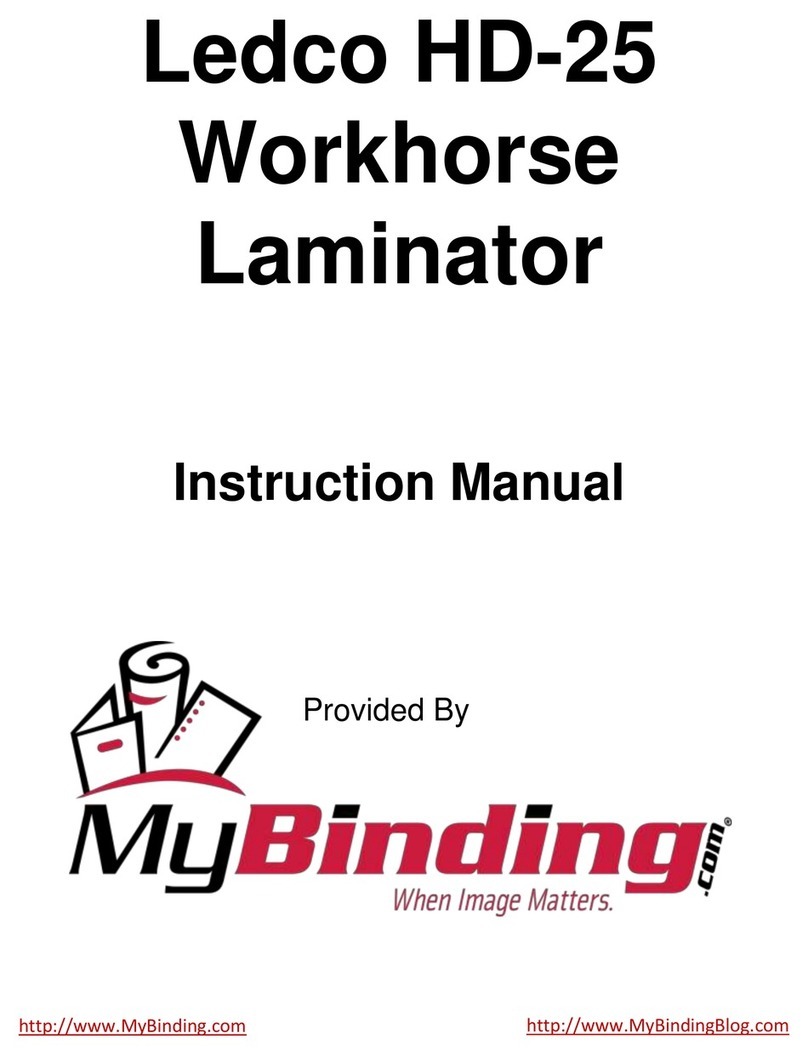cleanAIR CLF 475 User manual

Clean Air Techniek B.V.
User manual
English Version 5.0
Series CLF
Laminar crossflow-cabinet
Types:
CLF 475
CLF 575
CLF 675
Offers protection for product
Before using the cabinet, please read this
manual carefully. The required instructions
have to be carried out first.
Clean Air Techniek B.V.
Kuipersweg 37
3449 JA Woerden
The Netherlands
Phone: +31 (0) 348 41 11 14
Fax: +31 (0) 348 42 26 84
Internet: www.cleanair.eu

UM-CLF-XX-EN05.doc
2
Preface
Clean Air provides a complete range Laminar Airflow Cabinets for handling of non-hazardous
materials, which require a clean particle free environment. The cabinets offer the highest product
protection. The horizontal airflow prevents contaminated outside air to enter the workstation's
work area, ensuring product protection.
Its application is in the field of pharmaceutical industry, biotechnology, pharmacies, hospital and
university laboratories as well as tissue culture and electronic laboratories.
The CLF is a high-quality product constructed with high-grade components and materials, with
new techniques, such as:
Microprocessor control with a LCD display for the interface with the user;
Automatic up speeding fan; when there is increasing resistance in the filter the necessary
airspeeds are maintained;
Integrated drain on the backside of the working surface to prevent spilled liquids to leak in
to the HEPA filter;
White laminated wooden or stainless steel (304) working surface;
All internal areas of the working space are in line with the effective HEPA filter area, to
obtain a laminar flow;
Side windows of safety glass for a good overview.
Furthermore the CLF is a service friendly cabinet, produced in The Netherlands.
We thank you for buying this cabinet and wish you good times working with this cabinet.
Clean Air Techniek B.V.
Version table
Vers. 5.0 25-11-09 MPE Document structure updated
Version: Date: From serial
number:
By: Check: Change:
©Copyright 2009
All rights reserved. Nothing from this edition may be copied, or used in an automated database, or made public, either electronic,
mechanical, by photocopies, recordings, or in any manner, without preceding written permission of Clean Air Techniek B.V. This also
counts for the accompanying figures and/or plans.
Clean Air Techniek B.V. is entitled to change parts on each desired moment, without preceding or direct notification of the customer.
The content of this user manual can be changed without preceding warning as well. For information concerning maintenance activities
or repairs which are not mentioned in the user manual, please contact the service organization.
This user manual has been put together with all possible care, but Clean Air Techniek B.V. cannot take the responsibility for possible
mistakes in this user manual or for the consequences of it.

CLF Laminar crossflow-cabinet Clean Air Techniek B.V.
UM-CLF-XX-EN05.doc
3
Index
1Introduction _______________________________________________ 6
1.1
CLF__________________________________________________________________6
2Safety regulations ___________________________________________ 7
2.1
Use in conformity with regulations _________________________________________7
2.2
Modifications and changes to the cabinet____________________________________7
2.3
Authorized persons _____________________________________________________7
2.4
General safety aspects __________________________________________________8
2.5
Explanation user safety symbols ___________________________________________9
3Cabinet __________________________________________________ 10
3.1
Assembly-instruction ___________________________________________________10
3.2
Transport instructions __________________________________________________11
3.3
Dismantling & Disposal _________________________________________________11
4Product description _________________________________________ 12
4.1
Type plate ___________________________________________________________12
4.2
Front panel __________________________________________________________12
4.3
Worktop _____________________________________________________________13
4.4
Plenum-construction ___________________________________________________13
4.5
Crossflow filter________________________________________________________13
4.6
Pre-filter _____________________________________________________________13
4.7
Support frame (optional)________________________________________________13
4.8
Main power connection _________________________________________________14
4.9
Electronics ___________________________________________________________14
4.10
Operating panel _______________________________________________________15
4.11
FL-lighting ___________________________________________________________15
4.12
Fan _________________________________________________________________15
4.13
Optional features ______________________________________________________15
5Control___________________________________________________ 18
5.1
Using the cabinet______________________________________________________18
5.2
Display interface ______________________________________________________18
5.3
Starting up the cabinet _________________________________________________19
5.4
Locking functions cabinet _______________________________________________20
5.5
Power save mode _____________________________________________________21
5.6
Turn off _____________________________________________________________21
5.7
Control UV (optional)___________________________________________________22
5.8
Control sockets (Optional)_______________________________________________22
5.9
Menu functions _______________________________________________________23
5.10
General Information ___________________________________________________23
5.11
Information status cabinet ______________________________________________32
5.12
Settings _____________________________________________________________35
6Alarms ___________________________________________________ 38

CLF Laminar crossflow-cabinet Clean Air Techniek B.V.
UM-CLF-XX-EN05.doc
4
6.1
Flow alarms __________________________________________________________38
6.2
Other alarms _________________________________________________________39
7Cleaning__________________________________________________ 41
7.1
Cleaning the installation ________________________________________________41
7.2
Cleaning the UV-light (optional) __________________________________________41
8Small maintenance and testing ________________________________ 42
8.1
Periodic maintenance __________________________________________________42
8.2
Replacement of the pre-filter ____________________________________________42
8.3
Replacing the fluorescent-light (FL light) ___________________________________43
8.4
Service contact _______________________________________________________44
8.5
Service contract _______________________________________________________44
8.6
Testing ______________________________________________________________44
9Technical specifications ______________________________________ 45
9.1
Physical surrounding ___________________________________________________45
9.2
General specifications __________________________________________________45
10 Trouble shooting ___________________________________________ 48
Appendix I: Support frame CLF ____________________________________ 49
Appendix II: Replacement of the HEPA-filters ________________________ 50
1.
When does a HEPA filter need to be replaced? ______________________________50
2.
replacing the HEPA-filter ________________________________________________50
Appendix III: Efficiency test of the HEPA-filters _______________________ 52
Requirements ______________________________________________________________52
Appendix IV Measuring method air velocities _________________________ 53
Air velocities crossflow _______________________________________________________53
Appendix V: Lay-out boards ______________________________________ 54
Appendix VI: Alarm-test procedure_________________________________ 55
Appendix VII: Stickers __________________________________________ 57
Appendix VIII: Information installed options _________________________ 58
Installed options microprocessor _______________________________________________58
Appendix IX: User code__________________________________________ 61
Activating the user code _____________________________________________________61
Changing the user code ______________________________________________________62
Appendix X: Required specifications ________________________________ 63
Overview of the required specifications__________________________________________63
Appendix XI: Recommended spare parts list _________________________ 64
Appendix XII: TUV Low Pressure Mercury Lamps (Optional) _____________ 65
Appendix XIII: Statement of the agreement for machines _______________ 66
Appendix XIV: Memo____________________________________________ 67

CLF Laminar crossflow-cabinet Clean Air Techniek B.V.
UM-CLF-XX-EN05.doc
5
Index________________________________________________________ 68

CLF Laminar crossflow-cabinet Clean Air Techniek B.V.
UM-CLF-XX-EN05.doc
6
1Introduction
1.1
CLF
The laminar crossflow-cabinet CLF has as purpose that the working surface is kept clear of
particles by means of a clean laminar crossflow of air. By applying a HEPA-filter (High Efficiency
Particulate Air) it is possible to work in this cabinet under conditions which are sterile, dust-free, or
aseptic. The cabinet, therefore, offers a product protection.
Short description of the CLF
•At the top of the cabinet the inflow air is drawn
through a pre-filter by a fan.
•This fan blows the air in the correct proportion to
the crossflow HEPA-filter. Because the crossflow
air passed through a HEPA-filter (High Efficiency
Particulate Air), the working surface is free of
particles.
•The airflow in the workspace is crosswards, thus
preventing background air to flow into the class A
workspace.
•The air flow leaves the cabinet by the work
opening.
Figure 1: Sectional view CLF

CLF Laminar crossflow-cabinet Clean Air Techniek B.V.
UM-CLF-XX-EN05.doc
7
2Safety regulations
ATTENTION!
Before starting service with the cabinet always ask the responsible person if there is no danger
for the service engineer, labor personnel, the laboratory and the surrounding of the cabinet.
2.1
Use in conformity with regulations
Personnel that is not properly informed about the safety regulation and/or does not meet the
requirements mentioned in
§2.3
Authorized persons
on page 7
, is not allowed to use the cabinet.
Improper use of the cabinet is not allowed.
2.2
Modifications and changes to the cabinet
In order to operate the cabinet safely changes and/or alterations shall only be made by Clean Air
Techniek B.V., or shall be made after consultation with and permission in writing from Clean Air
Techniek B.V. If modifications and changes are made on own initiative, without permission from
Clean Air Techniek B.V., the parts of the cabinet concerned are no longer covered by the warranty.
Clean Air Techniek B.V. cannot be held liable for the consequences of the modifications and the
dangers, which might possibly occur as a result. The modifications mentioned here include the
connection of the cabinet to an exhaust system.
2.3
Authorized persons
Operating the cabinet
The cabinet shall only be used by personnel which:
is familiar with the content, regulations and warnings which are mentioned in the user manual;
is familiar with how to operate the cabinet;
is familiar with the start up procedure, the stop procedure and knows how to react in case of
emergency;
is familiar with the regulations to keep the safety in all circumstances;
is capable to end a disturbance.
Maintenance and repairs general
Maintenance shall only be performed by qualified service engineers, who are sufficiently trained by
Clean Air Techniek B.V. to:
Estimate and avoid the dangers of the cabinet;
Estimate the consequences of their actions.
Before starting maintenance to the cabinet (mechanical and/or electric) disconnect the power
supply. Pay attention to rotating parts, after switching off the cabinet the fans will still rotate
for a while.

CLF Laminar crossflow-cabinet Clean Air Techniek B.V.
UM-CLF-XX-EN05.doc
8
Maintenance and repair of the electrical cabinet
Maintenance shall only be performed by professional electro-technical service engineers, who are
sufficiently trained by Clean Air Techniek B.V. when:
They can estimate and avoid the dangers of the cabinet;
They can estimate the consequences of their actions;
They are sufficiently informed about the operation of the cabinet and the operation of the sub-
systems.
2.4
General safety aspects
1. The cabinet shall never be used unless the fan is switched into work mode and there is no
alarm.
2. When the cabinet is not used, the cabinet should be switched in to power-save mode or
closed/covered, to prevent that dust particles etc. from the room can get into the cabinet.
3. Always try to limit the amount of equipment in the workroom. Each object in the workroom
will disturb the pattern of the airflow and a large number of equipment may lead to serious
disruptions.
4. It’s is important that the cabinets will be kept clean. Even the smallest contamination which
is not visible will be easily forgotten. It is important to clean often the working area,
especially the work top.
5. Be careful with flammable liquids such as alcohol. The airflow is in the direction of the
person, so be very careful, or even better; prevent to use this kind of liquids.
6. The use of hand gloves and over sleeves is recommended.
7. Always use a chair with the correct height.
8. Transport and installation of the cabinet is only allowed for authorized staff. Please contact
the manufacturer or the seller of the products

CLF Laminar crossflow-cabinet Clean Air Techniek B.V.
UM-CLF-XX-EN05.doc
9
2.5
Explanation user safety symbols
GENERAL DANGER
You can harm yourself and others seriously if you
do not follow the procedures carefully
HIGH VOLTAGE
DANGER OF EXPLOSION
DANGER BY INDUSTRIAL VEHICLE

CLF Laminar crossflow-cabinet Clean Air Techniek B.V.
UM-CLF-XX-EN05.doc
10
3Cabinet
GENERAL DANGER
Be careful: high centre of gravity, crossover point.
The cabinet must be installed in a safe way. Clean Air Techniek B.V. supplies an optional support
frame, which is designed for this purpose.
When the cabinet is purchased without a support frame, it is advised to discuss the installation
with the supplier.
3.1
Assembly-instruction
The cabinet has to be placed on the support frame recommended by the supplier. The assembly
needs to be done as specified in instruction underneath.
Assembly support frame (Optional)
Build the support frame (see also

CLF Laminar crossflow-cabinet Clean Air Techniek B.V.
UM-CLF-XX-EN05.doc
11
Appendix I: Support frame CLF on page 49 for an explaining drawing):
•Mount the support yokes (Pos. 5) to the reinforcement plate (Pos. 6);
•Mount the feet support (Pos. 7);
•Position the covers (Pos. 4) and adjusting feet (Pos. 3).
Placing the cabinet
•Place the cabinet right on the forks of a forklift truck or lifting platform;
DANGER BY INDUSTRIAL VEHICLE
Be careful: Make sure the cabinet cannot slide from
the forks.
•Move the cabinet to the correct height and position, perform this action as precise as possible
above the support frame;
•The weight must be equally divided between the both forks and the cabinet must be horizontal
levelled;
•The cabinet should be aligned with the support frame.
•Mount the cabinet to the support frame by means of the screws.
•Connect the powerplug to a grounded socket that is easy accessible.
In case of maintenance the cabinet must be completely free of voltage. This means that the
connector in the socket must be easy to reach, otherwise a main-switch must be mounted
between the cabinet and the power supply so that the cabinet can be cut off of the power-circuit.
3.2
Transport instructions
Before moving the cabinet make sure the power cable is disconnected of the power supply
The cabinet must be transported on a strong solid pallet.
After every transport the cabinet must be tested and calibrated.
GENERAL DANGER
Be careful: High center of gravity, crossover point.
3.3
Dismantling & Disposal
For dismantling and disposal follow the next instructions:
•See
§7.1 Cleaning the installation on page 41;
•See
§8.2 Replacement of the pre-filter on page 42
;
•
See
Appendix II: Replacement of the HEPA-filters
on page 50;
•Break the unit down into its component parts. You can re-cycle these components parts,
dispose of them in accordance with local requirements.
For advice or information about dismantling or disposal please contact Clean Air Techniek B.V.

CLF Laminar crossflow-cabinet Clean Air Techniek B.V.
UM-CLF-XX-EN05.doc
12
4Product description
Figure 2 Sectional view CLF
Partlist:
1. Pre-filter
2. Fan
3. Plenum-construction
4. Front panel + control panel + I/O board
5. HEPA-filter
6. Lighting
7. Worktop
4.1
Type plate
On type plate (right upper side) there are instructions that are important for the connection of the
cabinet.
4.2
Front panel
Behind the front panel (Figure 2, Pos 4) a number of electrical components are mounted.
Operating panel / operating board
Interface board, including fan control
To check one of these components, you need to open the front panel.

CLF Laminar crossflow-cabinet Clean Air Techniek B.V.
UM-CLF-XX-EN05.doc
13
4.3
Worktop
The workroom contains a white laminated wooden or stainless steel (304) worktop (Figure 2, Pos
7).
4.4
Plenum-construction
The plenum-construction (Figure 2, Pos 3) equalizes the air trough the crossflow filter.
4.5
Crossflow filter
The crossflow HEPA-filter*(Figure 2, Pos 5) has a very high efficiency: Class H14 in accordance
with EN1822. After assembling, each filter will be tested separately. Through the service panel on
the back the crossflow filter can be reached.
*) High Efficiency Particulate Air filter
4.6
Pre-filter
The pre-filter (Figure 2, Pos 1) is a filter in the class G3 accordance with EN779. Furthermore the
pre-filter will enhance the life span of the HEPA-filter significantly.
4.7
Support frame (optional)
For a stable positioning of the cabinet we recommend the use of a support frame. For a good
ergonomic work position the use foot support is present. In addition, it is recommended to use an
in height adjustable, well disinfectable, chair to optimize the work position. See

CLF Laminar crossflow-cabinet Clean Air Techniek B.V.
UM-CLF-XX-EN05.doc
14
Appendix I: Support frame CLF on page 49.
4.8
Main power connection
The main power connection is positioned on the top of the cabinet. The power cable length is
maximum 3 meters and should always be accessible. See technical specifications for details.
4.9
Electronics
The electronics (Figure 2, Pos 4) consists of:
•Operational print; positioned in the top hood behind the front panel;
•Control print, positioned behind the front panel, including:
oFuse holders (see §9.2 on page 46 for fuse-numbers).
oFan control. The control is free adjustable in the range between 0% and 100%
oAn Air velocity compensating microprocessor regulates the fan speed to compensate
for main power fluctuations and filter pollution.
oIndependent potential free output contact (interface board connector J6).
See Interface board on page 54.
oMain filter
oLight ballast + starter for UV (Option)
oLight ballast for FL-light

CLF Laminar crossflow-cabinet Clean Air Techniek B.V.
UM-CLF-XX-EN05.doc
15
4.10
Operating panel
Figure 3: Operating panel
The operating panel (Figure 3, Figure 2, Pos 4) consist of:
1- Display;
2- Function keys (4x);
3- Fixed keys (4x);
4- Signals.
4.11
FL-lighting
The Fluorescent-Lighting (Figure 2, Pos 6) is mounted in the Light unit.
HIGH VOLTAGE
4.12
Fan
The electric driven double suction fan (Figure 2, Pos 2) is maintenance-free.
4.13
Optional features
Gas connection
This connection is assembled together with a gas tap. Normally, both the inlet and outlet gas
connections are hose connections, suitable for hoses with an inner diameter of 10 mm. All
connections on the gas supply have to be done with a certified gas hose.
After the connection on the gas supply, the gas connections have to be tested on leakage by a
certified installer.

CLF Laminar crossflow-cabinet Clean Air Techniek B.V.
UM-CLF-XX-EN05.doc
16
Positions of the supply connection
•The connection, that is located inside the installation, is standard assembled on the
worksurface inside the work space of the cabinet.
•The connection, that is located outside the installation, is standard assembled in the bottom of
the installation.
Bunsen burner
Recommended to apply is the Fuego Bunsen burner, available at Clean Air Techniek B.V.
Positions of the supply connection
•The connection is standard through the workopening.
Vacuum/ O
2
/ N
2
and compressed air connections
These connections are always assembled in combination with a tap.
Positions of the supply connection
•The connection, that is located inside the installation, is standard assembled in combination
with a tap in the worksurface.
•The connection, that is located outside the installation, is standard assembled in the bottom of
the installation.
UV-Radiator
The UV radiator is meant for disinfecting the working surface of the cabinet.
When the UV-radiator is on, the TL lighting will be switched off. The UV radiator may only be
switched on when the work space of the cabinet is entirely closed, this makes sure that the user
will not get in contact with UV-C radiation. Block the front aperture (a special night door can be
ordered for this purpose).
DANGER FOR BURNING
Avoid direct contact with UV-C radiation. This causes
burns to the skin and eyes.
The UV light can be switched on and off on the display (see §5.7 on page 22). It is also
possible to adjust the UV disinfection, for each day a certain disinfection period can be defined
(see §5.10 on page 24).

CLF Laminar crossflow-cabinet Clean Air Techniek B.V.
UM-CLF-XX-EN05.doc
17
Watch Out!
Do not touch the UV-lamp with the hand and keep the
lamp fat free; otherwise the lifetime will decrease. The
UV-light must be cleaned with alcohol (70%) regularly
(switch off the installation ). See §7.2 on page 41.
When the UV is switched on, the UV hour counter counts the lighting period. UV-lamps have,
depending on fabricate and type, a limit in effective running hours. Replace the lamp frequently.
For more info see Appendix XII: TUV Low Pressure Mercury Lamps (Optional) on page 65.
Sockets
The sockets are mounted in the working area.
They can be operated at the control panel. See
“
Technical specifications”on page 45 for electrical
details.
Alternative Options
Please contact Clean Air Techniek B.V. for information about alternative options.

CLF Laminar crossflow-cabinet Clean Air Techniek B.V.
UM-CLF-XX-EN05.doc
18
5Control
5.1
Using the cabinet
Check if the information on the type plate is corresponding to the main power connection.
Connect the cabinet to the main connection by putting the plug into a grounded socket that is
easy accessible.
5.2
Display interface
Figure 4 Display Interface
The operating panel (
Figure 3
and
Figure 4
) consists of:
1. Display;
2. Function keys (4x);
3. Fixed keys (4x);
4. Signals.
Display:
The display has 4 lines, the lowest line gives the description of the function key underneath.
I
II
III
IV
Cabinet switched off –not safe
Monday 11:06:33
MENU
Socket=Off
Fixed keys:
Lighting ON/OFF
Work mode fan ON/OFF
Power save mode fan ON/OFF
Acknowledge / Enter

CLF Laminar crossflow-cabinet Clean Air Techniek B.V.
UM-CLF-XX-EN05.doc
19
Function keys:
The function of keys 1, 2, 3 and 4 is variable. In the last line of the display the function is shown.
Signals:
Alarm: Confirmed alarm state
Alarm, flashing (along with acoustic signal):
Actual alarm
UV: Indication UV-light switched on
OK: Safe user mode
All equipment and, if possible, all materials required for working with the cabinet need to be
placed into the installation before starting up the cabinet. High equipment or objects can be placed
in the working space by sliding or hinging the window upwards. Be careful: keep the safety
regulations in consideration.
5.3
Starting up the cabinet
1
The lighting of the display will
light up.
The alarm indicator light is red
.
•Connect the power cable.
Cabinet switched off –not safe
Monday 11:06:33
MENU
Socket=Off
2
The fan starts.
Cabinet is in start up mode.
The alarm indicator light is red
.
There is an acoustic alarm.
•Push button .
•To acknowledge this alarm, push button .
Starting to work mode –not safe
Monday 11:06:33
MENU
Socket=Off
3
If the cabinet is secured with a
user code, this code has to be
entered first.
The default code is 0001.
The user code can be changed
by the user, see Appendix IX:
User code on page 62.
•Enter actual user code.
•Confirm the code with button .
User code:
0000 (Enter code)
A = Enter
>>
+
- Esc
4 The light will switch on. •Push button .
5
When the fan has reached the
right airspeed, the alarm
indicator will disappear.
The following display will be
shown.
However, the cabinet must operate for minimally 15
minutes more, before the cabinet is ready to work with.
Cabinet in work mode – safe
Monday 11:06:33
MENU
Socket=Off

CLF Laminar crossflow-cabinet Clean Air Techniek B.V.
UM-CLF-XX-EN05.doc
20
6
If the air speeds still are not
right, the alarm will sound again.
To see what is wrong:
See § 5.11 on page 32 for more
info about this menu.
•Push button (Menu).
•Push button (B).
•Push button .
•Back to starting menu: button (Esc).
Starting to work mode – not safe
Monday 11:06:33
MENU
Socket=Off
A => Hour counter information
B => Status cabinet
C => Settings
A
B
C
Esc
Information Status Cabinet
A = Enter
=>
<=
Esc
Cabinet: Work mode
Airflow 0.36 < < 0.54 m/s
=>
<=
Esc
5.4
Locking functions cabinet
(Only when the locking function is activated)
1
The cabinet will lock its functions
after being 5 minutes in work
position.
When, within these 5 minutes, an arbitrary button is pushed
(e.g. lighting) the timer starts counting again.
2
From this moment the fan-
buttons are not available
anymore.
The user code has to be entered
to make the functions available
again. See Appendix IX: User code on page 62.
Cabinet in work mode - Safe
Monday 11:06:33
Cabinet is locked with pincode
MENU
Socket=Off
3
If the cabinet has to be locked
immediately after entering the
code:
•Push button for 5 seconds
After 3 seconds, two short beeps will be heard as an
acknowledgement the cabinet has been locked.
4 To unlock the cabinet, the user
code has to be entered again.
See
Appendix IX: User code on page 62
.
This manual suits for next models
2
Table of contents
Popular Laminator manuals by other brands
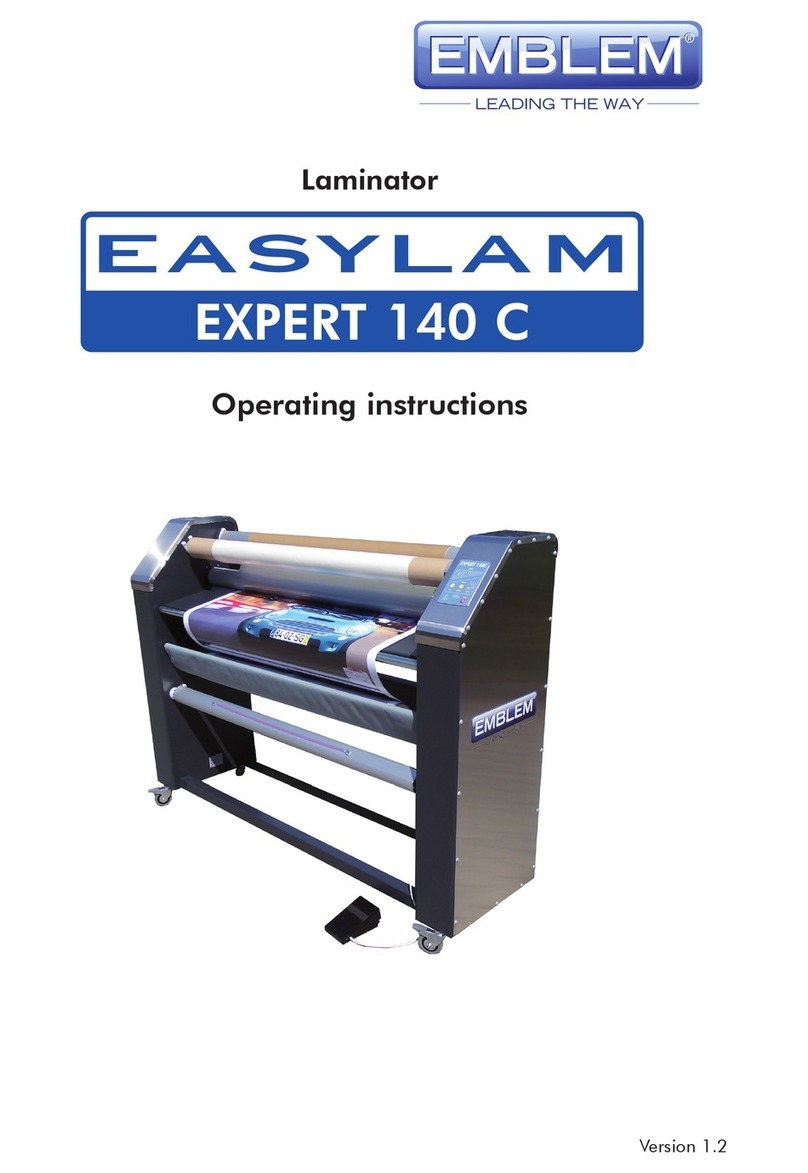
Easylam
Easylam EXPERT 140 C operating instructions

Royal Sovereign
Royal Sovereign RSC-880LS owner's manual
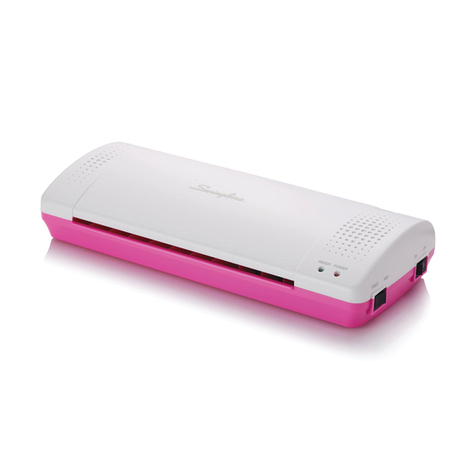
Swingline
Swingline Inspire Plus instruction manual

Royal Sovereign
Royal Sovereign HSH-1300 owner's manual
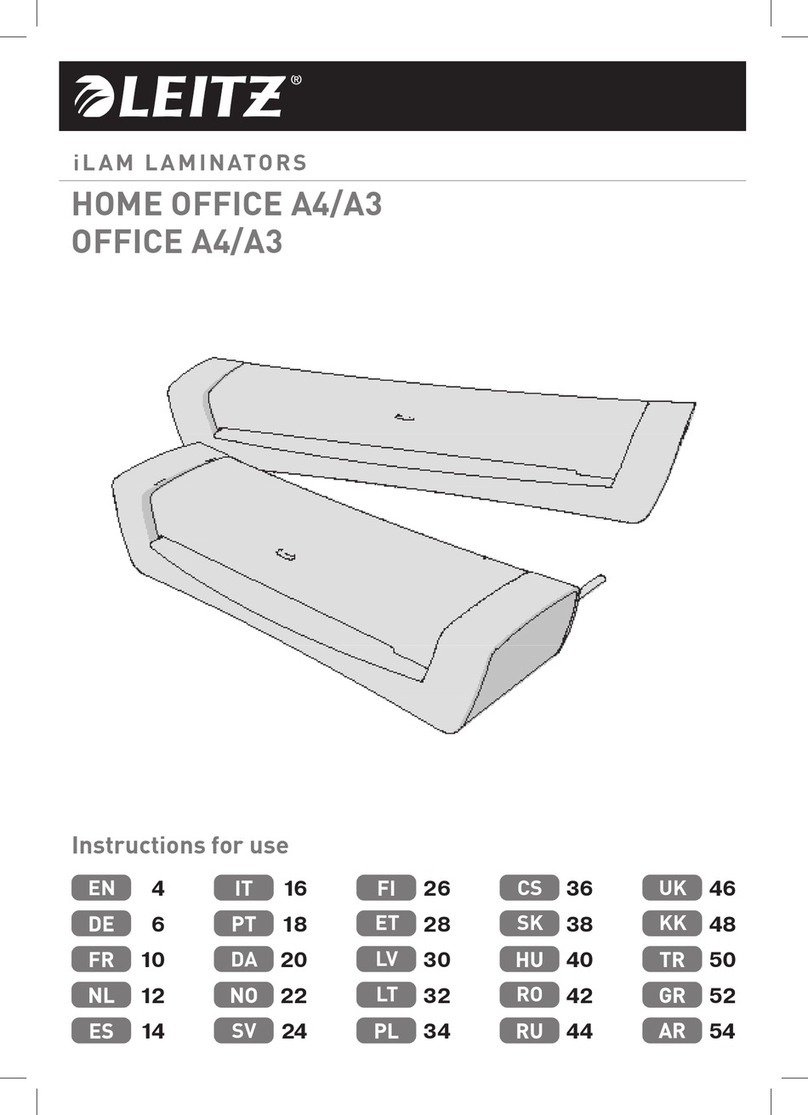
LEITZ
LEITZ iLAM Home Office A4/A3 Instructions for use
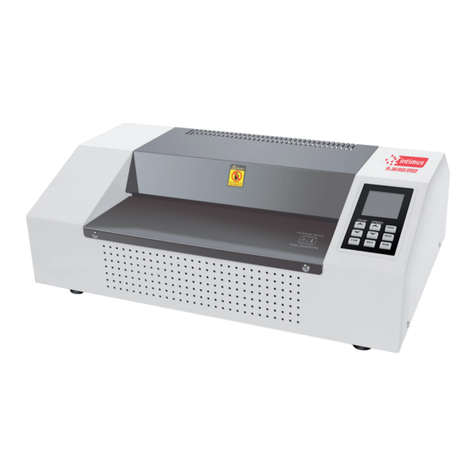
Intimus
Intimus PL-340 High Speed operating instructions
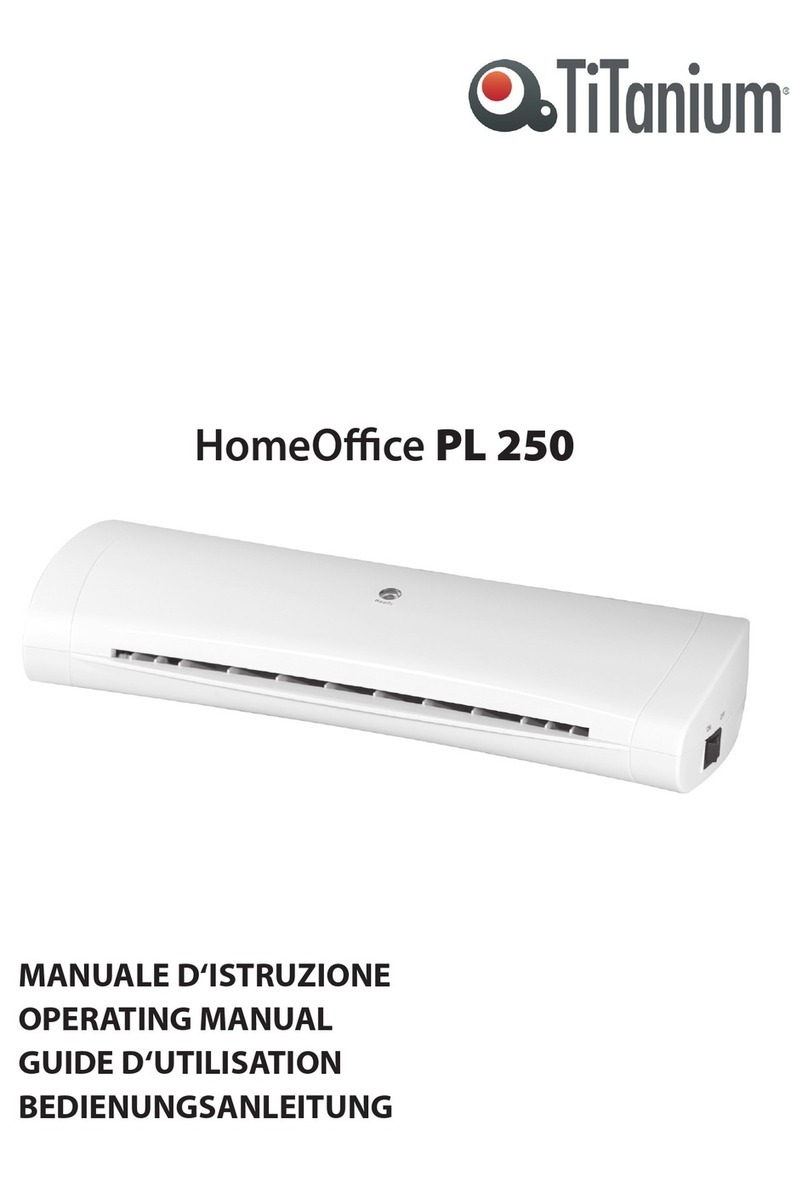
Titanium
Titanium HomeOffice PL 250 operating manual
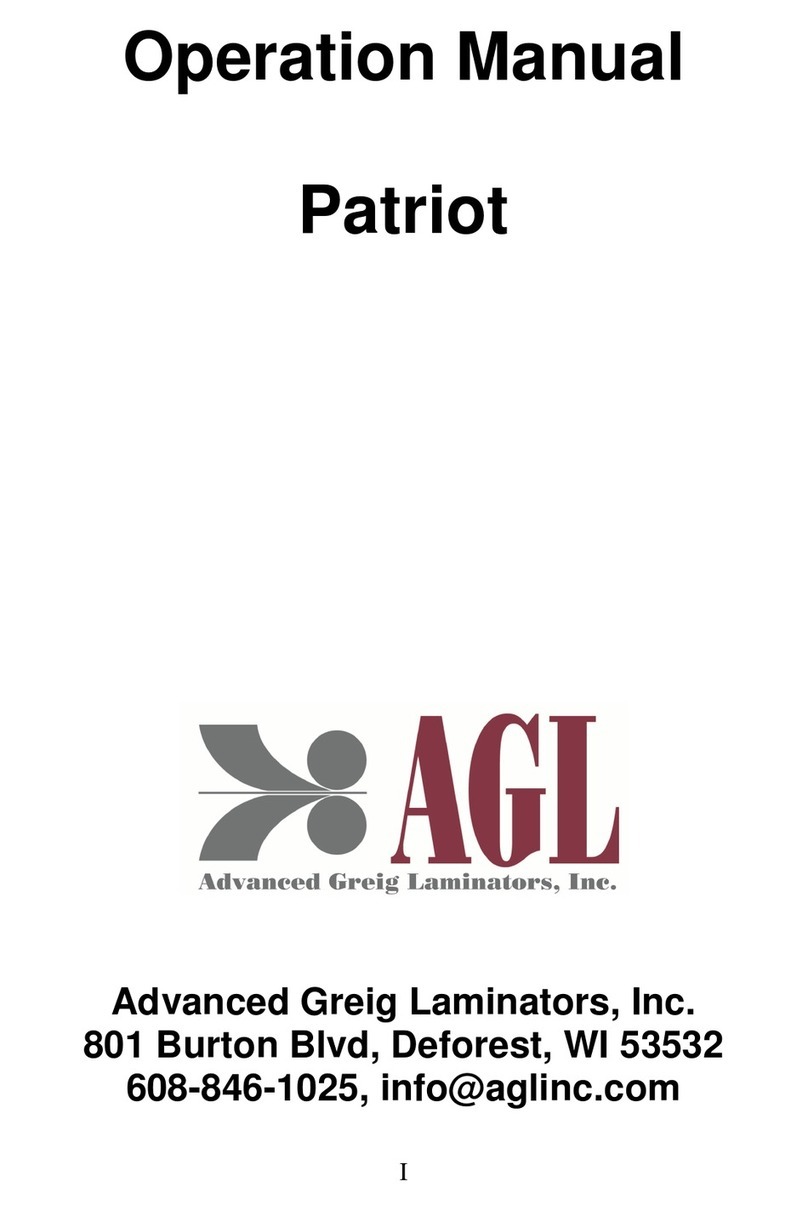
Advanced Greig Laminators, Inc.
Advanced Greig Laminators, Inc. Patriot Operation manual
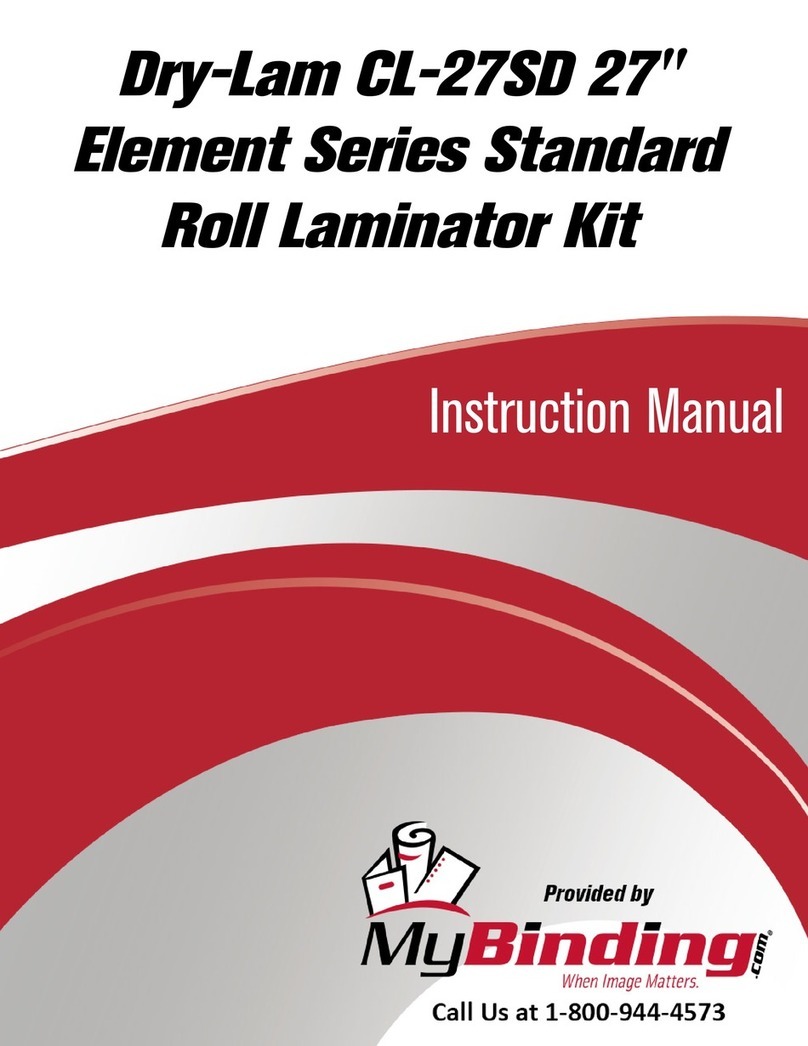
Dry-Lam
Dry-Lam CL-27SD instruction manual

Biosystem
Biosystem Style 260C operating instructions

Fellowes
Fellowes Mars 95 manual

Black & Decker
Black & Decker LAM95 manual


